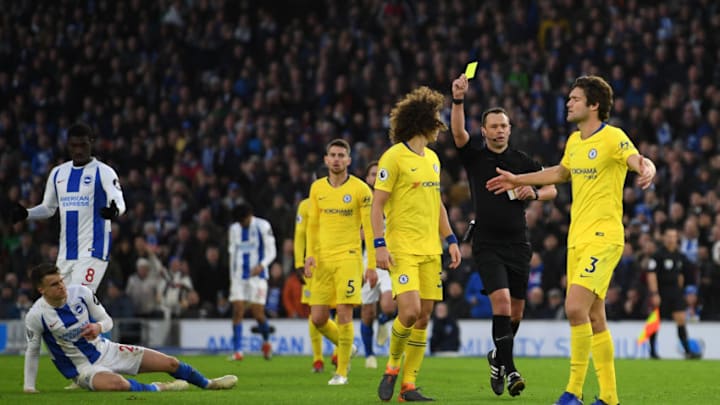Marcos Alonso could have received three yellow cards on Sunday in addition to the one he did receive, which should have been a red. Even so, and despite the predictable outcry, he should and will keep his place in the Chelsea XI.
Few players can rattle a shot off the woodwork, coming inches away from a 3-0 lead in the second half, and still be adjudged lucky and blessed by every available deity. Marcos Alonso is that rare player. Physics prevented him from giving Chelsea a comfortable lead in the 63′ that would have allowed them to see out the game. The much less objective, predictable and reliable Stewart Attwell made four decisions that allowed the Blues to finish with 11 men on the pitch.
Marcos Alonso committed two fouls eight minutes apart that could easily and fairly have been bookings. In the 60′, Anthony Knockaert dribbled out of his right defensive corner towards his own penalty box. He took a sharp turn at the edge of the area, had an open channel to dribble away from his goal and completed the turn impeccably. Alonso tripped him as Knockaert was about to break into that space. Attwell awarded Brighton a free kick, but no card for Alonso.
Eight minutes later – five minutes after he hit the post and two minutes after Solly March brought Brighton back into the game – Alonso battled Knockaert for a ball going out of bounds. As they jostled to avoid taking the last touch, Alonso’s right arm came up and flew into Knockaert’s face. Alonso did not elbow Knockaert and the contact did not appear intentional. But it was reckless at best and was unequivocally arm-to-face. But from Attwell’s angle the contact likely appeared shoulder-to-shoulder, so he made no call on the play.
Just under 20 minutes later Alonso finally received his yellow, and that, too, was fortunate. Attwell determined Solly March would not have been in control of the ball had he not been pulled down. That makes it a foul, but not a denial of a goal scoring opportunity (DOGSO!). The latter (DOGSO!) would have been a red card since Alonso was the last man back. Instead, it was a yellow.
Five minutes later, in the first minute of stoppage time, Alonso escaped another potential yellow for tripping a Brighton player leading up to a corner kick. While this was very much a run of the mill foul, at this point it was part of a persistent pattern by Alonso, which could move it into the bookable category.
Had Alonso received a yellow for either incident with Knockaert he would have been sent off for his foul on March, last-man-back-DOGSO or not. If Attwell had booked Alonso for both fouls on Knockaert, Alonso would never have been able to encounter Solly March. Whether you look at it from the perspective of two yellows or a straight red, Brighton have a solid case that Stewart Attwell cost them either 5 or 22 minutes of playing with a man advantage.
Despite having a half-hour so dependent on luck and permissive officiating, Alonso did not overall have a bad game. He had five defensive actions – more than either centre-back – and two shots. As usual he found good positions in the half-spaces and the penalty area, but also read the play well when Cesar Azpilicueta would overlap the winger on the right. Alonso responded to dropping deep towards the backline, ensuring the Blues maintained their full-back asymmetry and therefore their defensive strength.
The last time Chelsea had a player get away with so many clear fouls – including a red card-worthy offence – was against Everton, when the lucky undisciplined Blue was Jorginho. That game came as Chelsea’s opponents were starting to understand how brittle Jorginho is, and how brittle the Blues are around him. Everton were the second-most effective team to adopt counter-Jorginho tactics. Only Tottenham did better the following week.
Jorginho’s fouls against Everton, culminating in a reckless studs-up tackle against Gylfi Sigurdsson, were the product of his frustration building over the preceding games. Alonso has no such excuse or rationale, and in some ways that makes his easier to overlook. They were blips, anomalies, stupid things that are inexcusable and should never happen again but are not signs of any deeper deficiencies in the individual or the team tactics.
Maurizio Sarri did not drop Jorginho, for obvious reasons. He should not drop Marcos Alonso, for different reasons that should be equally obvious, but somehow are still not.
As far as Marcos Alonso’s critics are concerned, Emerson Palmieri is the Cristiano Ronaldo of left-backs. He is not. Whatever they see in Emerson, they should share their insights with Maurizio Sarri, Antonio Conte and Eusebio di Francesco. None of those managers saw Emerson as the starting left-back. None were swayed by Emerson’s pace, choosing the much slower Marcos Alonso and even-slower-than-that Aleksandr Kolarov.
If Marcos Alonso has another string of fouls like he did in the second half against Brighton, Maurizio Sarri will have reason for concern. If Alonso starts showing any other signs of indiscipline on or off the pitch, Sarri will have to investigate the root causes and see where he needs to intervene.
Stewart Attwell should have seen to it that Marcos Alonso would not be in Chelsea’s squad for the next 1-3 games. Since he didn’t, Maurizio Sarri and Alonso should say a prayer of gratitude. Alonso should assure the coach it won’t happen again and they should go about their business preparing for the next run of games.
